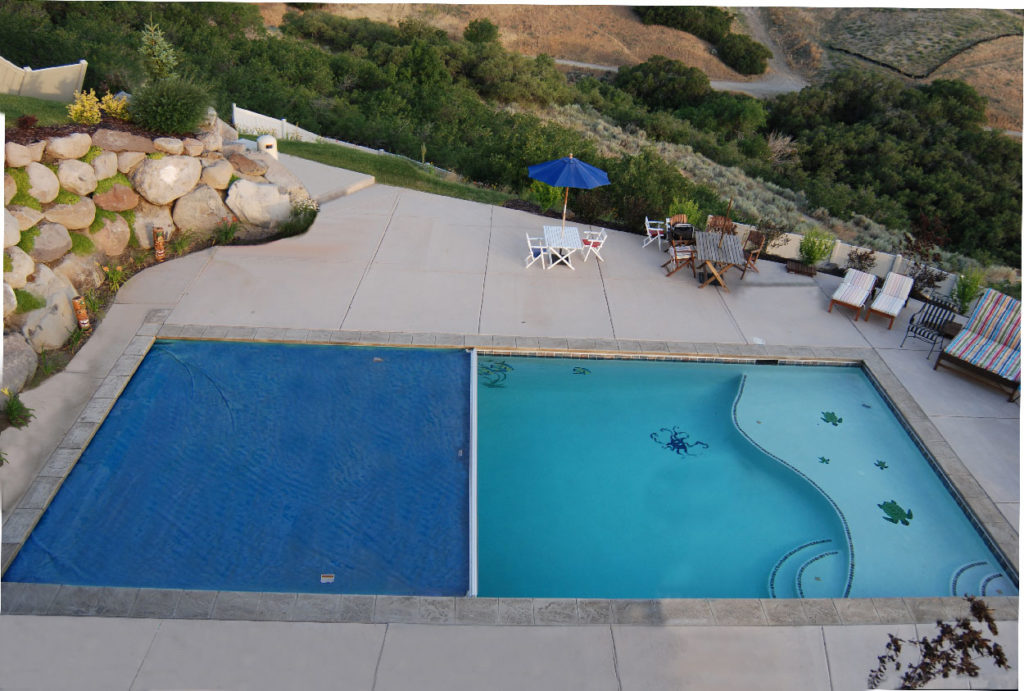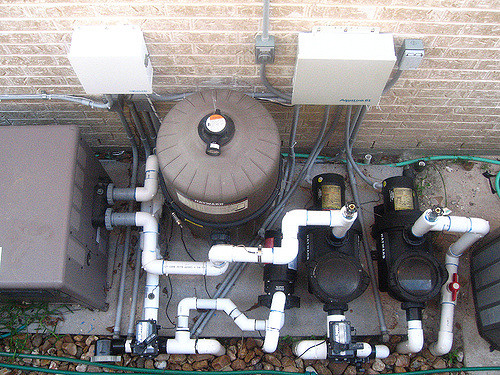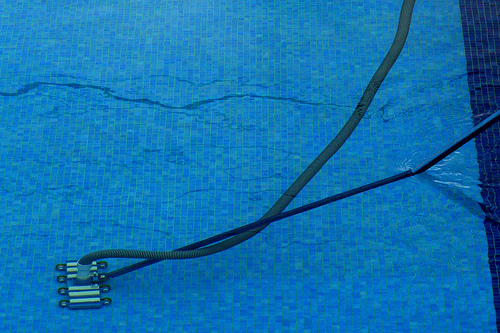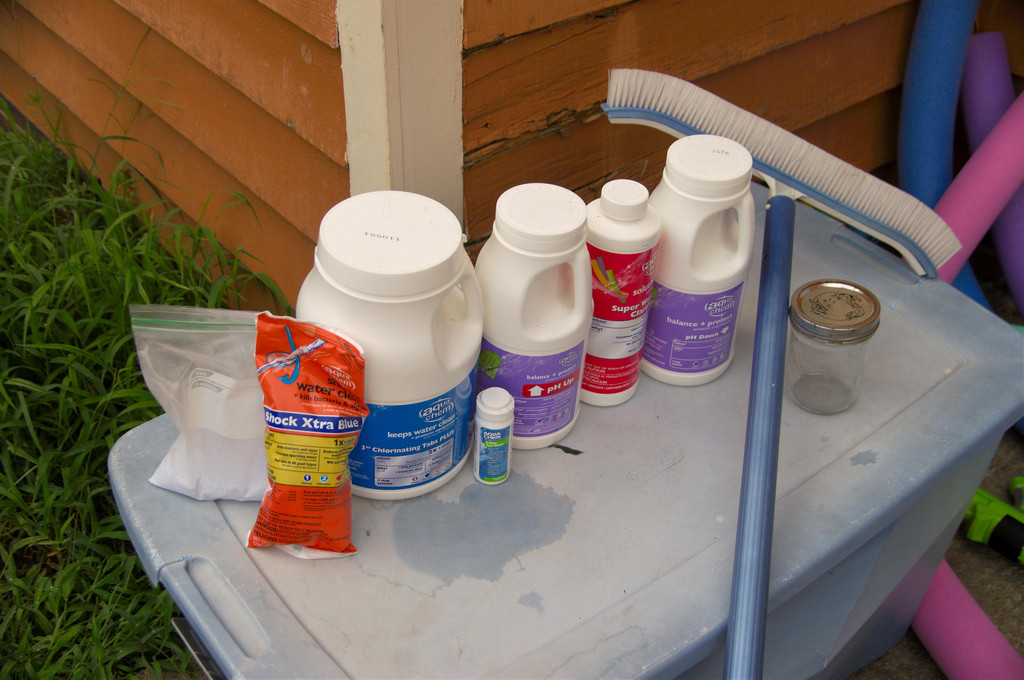Trying to figure out how to clean your pool after a storm? Keep reading, this post is for you.
As a pool owner, you make an effort to keep your pool as clean as possible. You handle your pool maintenance responsibilities, use a pool care schedule, and never let your chemicals levels drop too low. But sometimes, mother nature throws a fierce storm your way. And when the storm settles, you walk out to your pool and find it more closely resembling a backwoods pond
So what do you do in this situation? As overwhelming as it may feel at first, there’s a very simple and effective procedure you can follow to have your pool looking great in no time. In this post, we show you how to clean your pool after a storm, but first, let’s talk about storm-proofing your pool
+ Prepare your pool for a storm
Apply your cover



If you have a cover, then you already know this is a given. Using a cover helps prevent a significant amount of debris from getting in your pool water. But if you’re expecting a storm with heavier rainfall and winds, then it’s important to make sure that the cover allows for good drainage. This prevents the cover from caving in from the weight of the rainwater.
If your cover isn’t designed to withstand a storm, it may be better to not use it.
Add some preemptive shock and algaecide
If you’re not using a solar cover, then some pre-emptive chemical defense is your next best option. Since you can expect plenty of rainwater and debris to make its way into the pool, add chemicals to counteract it.
Adding pool shock helps keep your chlorine levels in balance and prevents the water from clouding up. Pairing that with algaecide prevents any surprise algae growth from happening.
[Is your water clouding up? Here’s a post on how to clean your pool water]
[Suprise algae attack? Here’s a post on how to clean a green pool]
Turn off all pool equipment (pool pump, pool heater)



This might be the most important action to take when preparing your swimming pool for a storm.
Why?
Because during a storm, essential pool equipment like your pool heater and pool pump are vulnerable to damage. From power surges to flooding, storms can create a list of problems.
So to eliminate this possibility altogether, cut off all power to your pool equipment. This means shutting off the pool heater and pool pump. If you believe there may be a flood risk, we recommend removing your pool pump to avoid any damage.
+ How to Clean Your Pool After A Storm
The forces of mother nature hit your pool, and you’re left to deal with the aftermath. Rest easy, this isn’t as bad as it sounds, we promise. In fact, you can be back in your pool within a few days if you follow these simple steps. Here’s how to clean your pool after a storm:
Skim the pool to remove surface debris
There’s going to be plenty of debris in your pool water to clean out after a storm. That’s a fact. Luckily, you can speed up the process by removing everything on the surface with your pool skimmer. Not only does this reduce the amount of total debris in your pool, but it also reduces your future workload.
With less debris in the pool, your pool chemical balance won’t be as unstable, leaving you less to worry about during the later steps of the cleanup process.
[Want to save time and cut down on pool care? Check out 11 Ways To Automate Pool Maintenance]
Turn on the pool pump



Now that you’ve fished out all those twigs and leaves floating on the surface, it’s time to put your pool pump and filter to work. Assuming you didn’t lose power during the storm, go ahead and restore power (at the breakers) to your pool pump. Turning on your pool pump starts the filtration process, and begins pulling in water from the skimmer and main drain lines.
This is when all those micro contaminants you can’t see with your eyes start to drop like flies. But you’re not in the clear just yet.
[Still using a single speed pump? Switching to a variable speed pool pump is just one of many energy saving tips for swimming pools]
Brush the walls
While your filter system/pool pump is running, scrub the walls of your pool. This lifts off any contaminants that may be clinging to the wall while breaking up any remaining grime/buildup. As you brush, your filter system will take care of most of what you scrub off.
Brush the pool walls evenly, and make sure to tackle the hard to reach spots, including the stairs, corners, and behind the ladder.
Of course, you could always let your automatic pool cleaner handle the brushing for you. Just depends on how much you enjoy the thrill of scrubbing your pool walls.
Vacuum the pool floor



Home stretch. You’ve skimmed the water, brushed the walls, and started the filter system back up. Now it’s time to remove any of the left over debris lurking on your pool floor. Maybe it’s sand, or maybe it’s a bit of pollen. Either way, it’s all taking a one-way trip to your filter.
Turn on your vacuum and begin vacuuming across the width of your pool, moving in straight lines as if you were mowing your grass. Once you’ve vacuumed, give the pump a few minutes to filter everything out. From there, your water should be looking pretty clear (assuming you’re not dealing with pool algae or cloudy water).
[Never vacuumed before? Here’s how to vacuum your pool]
Empty the skimmer baskets
Since your pump and skimmer help out a lot during this process, it doesn’t hurt to go ahead and clean them out as well. So unscrew the lid from your pool pump and empty out any debris sitting in the pump basket. Then walk over to your pool and empty out your skimmer basket. This will ensure that the chemicals you’re about to add don’t get absorbed by leftover sticks and leaves sitting in the baskets.



Balance the pool chemicals
You’ve done all the hard work to clean your pool, now it’s time for a little bit of chemistry. Grab your pool water test kit, and check your chemical levels.
Not sure what chemicals and levels to test for? Check out this post on pool chemistry.
The calm after the storm
You did it. Your swimming pool looks like a swimming pool again, and all it took was a bit of elbow grease and know-how.
Yes, it can be a handful to clean your pool after a storm, but with the right approach (much like the one you just learned), your pool can be fully operational in no time. It’s all about staying true to good pool maintenance habits — and if you use a pool care schedule, then getting through this guide was probably a breeze. And if not, congrats, you just leveled up as a pool owner.
If you found this post helpful, you might also want to read:
- 9 Ways To Prepare Your Pool For A Hurricane
- 21 Pool Care Hacks That Make Pool Maintenance Easy
- 11 Household Products For Cleaning a Pool


